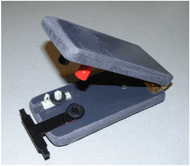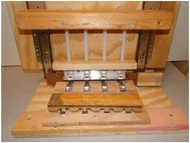IMPROVING WORKER PRODUCTIVITY THROUGH UNIVERSITY-INDUSTRY COLLABORATIONS
Allen H. Hoffman
Mechanical Engineering Department, Worcester Polytechnic Institute, Worcester, MA
ABSTRACT
Persons with diverse disabilities may be employed in assembly industries where they are paid by the number of units that they produce. Developing assembly and fixture devices can significantly increase an individual’s rate of production and therefore his/her pay. This paper describes a university/industry collaboration where engineering students in a lower level design course developed devices that could be used to simplify assembly processes and improve production rates.
BACKGROUND
Persons with physical and cognitive disabilities are often capable of being employed in assembly industries. Common job modifications include developing fixtures that hold components and thereby lower the physical requirements of the assembly process or modifying processes to lower the cognitive requirements. Although many of the required adaptations are not especially complex or expensive (Cook & Hussey, 2002), the industry often lacks the time commitment and/or skills to directly develop and implement these necessary solutions. Presently there are a number of governmental and social service agencies as well as private entities that can assist them in this process. However, it appears that industry collaborations with university engineering programs represent a major untapped resource that can also be utilized to develop effective solutions for worker accommodation.
GAAMHA Inc. was founded through the Gardner and Athol Mental Health Association and provides services to individuals with a wide range of disabilities (GAAMHA, 2015). Coleman Assembly & Packaging Inc. is a wholly owned GAAMHA subsidiary that provides hand assembly and packaging to a wide variety of industries (Coleman, 2015). Both organizations jointly occupy a 50,000 square foot facility in Gardner MA. Many of the Coleman employees are paid based upon the number of assemblies that they produce. Coleman management realized that the production rate (and pay) for many of their employees could be increased by the development of new assembly methods and fixtures that were more appropriate to the varying skill levels of their workers. They contacted the WPI Assistive Technology Resource Center (ATRC) at WPI for possible assistance.
WPI offers a number of undergraduate project based design courses. The ATRC provides a vehicle through which outside agencies can propose potential student projects for these courses as well as for major senior design projects and graduate research (Hoffman et al., 2001). Within undergraduate design courses students usually work in teams of four over a seven week term. Student teams are required to conduct background research on their selected project topic, create alternative designs for the solution of their problem, select a final design and then build and evaluate a working first generation prototype of their design. The student prototypes are required to demonstrate the feasibility of the design. However, these prototypes often have to be refined before they can be directly implemented.
METHODS
This paper describes two projects proposed by Coleman Assembly and Packaging. The first project was to modify the assembly of a mixing bucket. This project was undertaken by a group of four students enrolled in a first year Introduction to Engineering course (ES 1020). The second project was to improve the rate of production for two types of washer-post assemblies. Two groups of four students undertook this project in an Introduction to Engineering Design course (ME 2300) that enrolls primarily 2nd and 3rd year mechanical engineering students.
RESULTS
Mixing Bucket Assembly
 Figure 1. Ten quart mixing bucket.
Figure 1. Ten quart mixing bucket.
 Figure 2. Photo of the bucket mold and ring press.
Figure 2. Photo of the bucket mold and ring press.
Washer-Post Assemblies
The company has a number of contracts to assemble either fiber or rubber washers onto small plastic posts. The washers must be inserted over posts that have either a conical end or contain multiple ridges (Figure 3). The washers (grommets) and must be fully seated in order to be acceptable. The fiber washers are moistened prior to assembly. The assembly process requires fine motor skills, dexterity and good vision. The best employees can achieve production rates in the range of 500-600 units per hour. However, the work is tiring and can also affect the skin and nails on the dominant hand used in the process, particularly with the moistened washers. The goal of this project was to develop devices that would allow an increase in production rate, particularly for less able employees, and decrease or eliminate some of the undesirable effects of the current process.
 Figure 3. The respective washers must be placed on the conical post of black clip shown the left or the ridged post of the white dial shown on the right.
Figure 3. The respective washers must be placed on the conical post of black clip shown the left or the ridged post of the white dial shown on the right.
 Figure 4. Stapler design for pressing the washer onto the post. The grooves in the base align the posts beneath the hollow cylinders in the top arm of the device.
Figure 4. Stapler design for pressing the washer onto the post. The grooves in the base align the posts beneath the hollow cylinders in the top arm of the device.
Figure 4 shows a design developed by students Harry Lanphear, Kelly Beisswanger, Daniel Felix and Vinny Tavernelli. This design functions similar to a stapler and can used to produce either the clip or dial assemblies. The posts are placed in slots in the base of the device and the washers placed on top of the posts. The arm is pressed down to complete the assembly.
The proof of concept prototype (Figure 4) simultaneously produced one of each type of assembly. A production version of this design would produce two, or possibly more, units of the same type of assembly. While fine motor skills are required to place the components in the device, only gross motor skills are required to complete the assembly. The device was evaluated by Coleman employees and found to be quite effective.
Figure 5 shows a design developed by students Jason Zelle, Ni Pan and Michael Vaudreuil. This design is essentially a manual press which simultaneously completes four assemblies of grommets onto the ridged white posts. The grommets are placed in holders, the dials with ridged posts are then slid beneath the holders and the press is manually activated. The four completed assemblies are then pushed forward into a collection bin. This design minimizes
the fine motor skills necessary place the components in the device and only uses gross motor skills to complete the assembly. This first generation prototype was demonstrated to and evaluated by Coleman managers and employees. The device was enthusiastically received. As a first generation prototype, it was not of sufficient quality to allow for testing the actual production rates that could be obtained. The managers have requested that the students undertake refining the prototype so that it can be used in actual production. That process is currently underway.
 Figure 5. Press designed to simultaneously produce four dial assemblies.
Figure 5. Press designed to simultaneously produce four dial assemblies.
SUMMARY
Many job accommodations involve relatively simple, creative and inexpensive devices. The major challenge in developing these devices is to focus upon user abilities and the interface between the user and the device. The relative simplicity and creativity involved in developing appropriate devices make them ideal design projects for early stage engineering students. The projects presented in this paper demonstrate the mutual benefits that can accrue when engineering students undertake projects related to job accommodations. The engineering students gain real life design experience at an early stage of their education. The industrial partners gain access to resources that can creatively assist them to develop devices and processes to better accommodate their employees with disabilities. The employees benefit from implementation of accommodations that potentially increase their production rates and pay while simultaneously lowering the physical and/or cognitive requirements of their jobs.
REFERENCES
Coleman (2015). Coleman Assembly & Packaging, www.colemanap.com, accessed Jan. 12, 2015.
Cook, A. M., & Hussey, S. M. (2002). Assistive technologies: Principles and practice (2nd ed.). St. Louis, MO: Mosby Elsevier.
GAAMHA (2015), www.gaamha, accessed Jan. 12, 2015.
Hoffman, A. H., Ault, H. K. & Caticala, R. (2001). The development of a regional assistive technology resource center, Proceedings of the RESNA 2001 annual conference.
ACKNOWLEDGEMENT
The author would like to acknowledge Michael Barros and Alex Lazzari of Coleman Assembly and Packaging and the staff of GAAMHA for proposing these projects and assisting in their implementation.